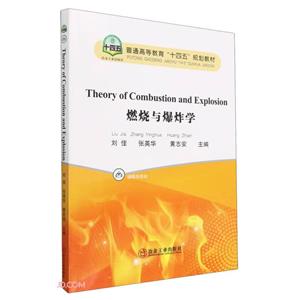预估到手价是按参与促销活动、以最优惠的购买方案计算出的价格(不含优惠券部分),仅供参考,未必等同于实际到手价。
-
>
宇宙、量子和人类心灵
-
>
(精)BBC地球故事系列-星际旅行
-
>
从一到无穷大
-
>
图说相对论(32开平装)
-
>
一本有趣又有料的化学书
-
>
刘薰宇的数学三书:原来数学可以这样学全3册
-
>
光学零件制造工艺学
THEORY OF COMBUSTION AND EXPLOSION 版权信息
- ISBN:9787502494414
- 条形码:9787502494414 ; 978-7-5024-9441-4
- 装帧:一般胶版纸
- 册数:暂无
- 重量:暂无
- 所属分类:>
THEORY OF COMBUSTION AND EXPLOSION 内容简介
AbstractThisbookmainlydealswithundergroundminingofmetalores,withtheengineeringgeologicalresearchthelaboratoryrockmechanicstesting,miningmethodselection,structuralandblastingparametersoptimizationsandtrialstopeminingapplicationconductedtooptimizeminingtechnologyforslowlyinclinedthinorebodies. Canbeconsultedbyresearchersandengineersinminingengineering,safetyengineering,etc.Itcanalsobeusedasabasicreferenceformineswithsimilarminingtechnologyconditions.
THEORY OF COMBUSTION AND EXPLOSION 目录
1.1 Nature and conditions of combustion and explosion
1.1.1 Combustion
1.1.2 Combustion theory
1.1.3 Conditions of combustion
1.1.4 Explosion and its characteristics
1.1.5 Explosion theory
1.1.6 Classification of explosions
1.1.7 Conditions for explosion
1.2 Theory of combustion reaction rate
1.2.1 Basic concept of reaction rate
1.2.2 Law of mass action
1.2.3 Arrhenius law
1.2.4 Combustion reaction rate equation
1.3 Calculation of combustion air volume
1.3.1 Theoretical air volume
1.3.2 Actual air volume and excess air coefficient
1.3.3 Fuel air ratio and excess air coefficient
1.4 Combustion products and their calculation
1.4.1 Composition and toxicity of combustion products
1.4.2 Calculation of product quantity in complete combustion
1.4.3 Calculation of flue gas volume in incomplete combustion
1.5 Calculation of combustion heat
1.5.1 Heat capacity
1.5.2 Combustion heat
1.6 Calculation of combustion temperature
1.6.1 Classification of combustion temperature
1.6.2 Calculation of combustion temperature
1.7 Chemical process of fire
1.7.1 Fire spreading speed
1.7.2 Fire products
1.7.3 Fire temperature
Exercises
Chapter 2 Physical Basis of Combustion and Explosion
2.1 Heat conduction
2.1.1 Fourier's law of heat conduction
2.1.2 Differential equation of heat conduction
2.1.3 Unsteady heat conduction
2.2 Thermal convection
2.2.1 Boundary layer
2.2.2 Newton's formula and convective heat transfer coefficient
2.2.3 Boundary layer analysis and solution of convective heat transfer process
2.3 Heat radiation
2.3.1 Basic concepts and laws
2.3.2 Radiation from hot gases and non-luminous flames
2.3.3 Luminous flame and hot smoke radiation
2.4 Transfer of substances
2.4.1 Diffusion of substances
2.4.2 Stephen flow
2.4.3 Buoyancy movement caused by combustion
2.5 Combustion and explosion phenomena in life
2.5.1 Heat transfer during candle burning
2.5.2 Mass transfer in candle combustion
Exercises
Chapter 3 Ignition Theory
3.1 Ignition classification and ignition conditions
3.1.1 Classification of fire
3.1.2 Ignition conditions
3.2 Semyonov thermal spontaneous combustion theory
3.2.1 Semenov's theory of thermal spontaneous combustion
3.2.2 Relationship between ignition temperature and vessel wall temperature
3.2.3 Relationship between mixture pressure and other parameters during ignition
3.3 Frank-kamenetsky spontaneous combustion theory
3.3.1 Frank-ramenetskil's thermal spontaneous combustion theory
3.3.2 Solution of critical criterion parameter 8- for spontaneous combustion
3.3.3 Theoretical application
3.4 Chain reaction
3.4.1 Thermal deflagration theory and its limitations
3.4.2 Concept of chain reaction
3.4.3 Straight chain reaction
3.4.4 Branch chain reaction (or branch chain reaction)
3.4.5 Ignition conditions of chain spontaneous combustion (development conditions of chain branching reaction)
3.4.6 Burning peninsula phenomenon
3.4.7 Chain reaction of hydrocarbon oxidation
3.5 Forced fire
3.5.1 Characteristies of forced ignition
3.5.2 Common ignition methods
3.5.3 Minimum energy for ignition
3.5.4 Electrode flameout distance
3.5.5 Semi–empirical formula for minimum ignition energy of electric spark in static air mixture
3.6 Spontaneous combustion of white phosphorus experiment
3.6.1 Experimental methods
3.6.2 Precautions
Exercises
Chapter 4 Combustion and Explosion of Combustible Gases
4.1 Laminar premixed flame propagation mechanism
4.2 Laminar premixed flame propagation velocity
4.2.1 Definition of flame propagation speed
- >
新文学天穹两巨星--鲁迅与胡适/红烛学术丛书(红烛学术丛书)
新文学天穹两巨星--鲁迅与胡适/红烛学术丛书(红烛学术丛书)
¥9.9¥23.0 - >
莉莉和章鱼
莉莉和章鱼
¥16.0¥42.0 - >
月亮与六便士
月亮与六便士
¥13.4¥42.0 - >
月亮虎
月亮虎
¥15.4¥48.0 - >
史学评论
史学评论
¥18.5¥42.0 - >
回忆爱玛侬
回忆爱玛侬
¥10.5¥32.8 - >
苦雨斋序跋文-周作人自编集
苦雨斋序跋文-周作人自编集
¥6.9¥16.0 - >
烟与镜
烟与镜
¥18.2¥48.0
-
一本有趣又有料的化学书
¥18.9¥45 -
物质的聚集状态及晶体结构基础
¥59.4¥108 -
化学晚会
¥6.4¥20 -
2022图书×抽奖盲袋
¥9.9¥25 -
2023读书月阅读盲盒——天黑,闭眼,刀谁?
¥42.3¥158















